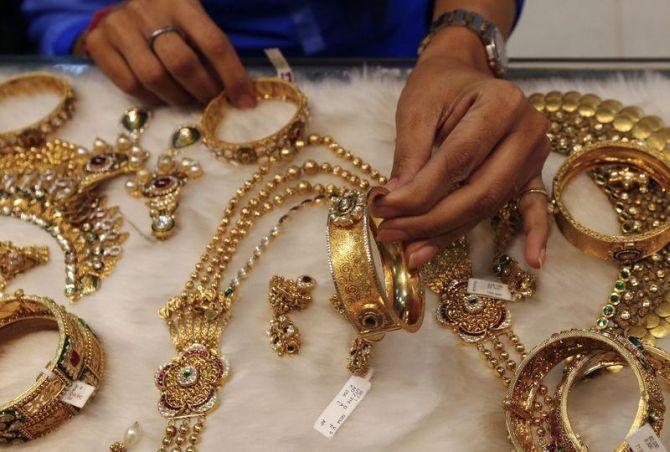 | « Back to article | Print this article |
The possibility of the slowdown affecting more players is greater if the industry doesn't get access to easier finance in the next six to eight months.
Pavan Lall reports.

At a recent meeting between the government and representatives from the Gem Jewellery Export Promotion Council, leaders have stressed that the absence of finance for the cash-hungry industry is being addressed, but industry experts have warned that if the current situation persists, the consequences could affect the country's exports.
The crisis was triggered by a couple of factors acting together -- the multi-billion-dollar Nirav Modi-Punjab National Bank scam, the combined side-effects of demonetisation and the goods and services tax regime, and further tightening of non-banking financial companies by regulators following the Infrastructure Leasing & Financial Services (IL&FS) problems.
"Banks have stopped lending and have also curtailed existing limits which are affecting the diamond industry," said Anoop Mehta, president of the Bharat Diamond Bourse.
Last year, the diamond sector had witnessed bankruptcy, with at least four or five casualties reported in Mumbai, and around 20 in Gujarat, he said.
"Factories are staying closed longer, and diamond houses have re-opened two weeks after the Diwali Holidays," Mehta said.
"Lending to existing clients is going on (but) there is no new business," Union Bank of India Managing Director and Chief Executive Rajkiran Rai G said.
The bank tightened the monitoring of books of borrowers from the gems and jewellery industries, he stressed.
"The bank is also doing more due diligence on debtors or buyers who are borrowing from us."
The jewellery industry has for long been petitioning the government to reduce duties on gold by 6% from the current 10%, and that on diamonds to 2.5% from the present 7.5%.
Recently, Minister of Commerce and Industry Suresh Prabhu tried to boost the morale of industry representatives with encouraging comments, but that did not work much.
The reason was the fact that new money was not being disbursed.
One Kolkata-based jewellery wholesaler, who declined to be identified, said, "regardless of what government officials, banks or industry bodies may say, business funding is frozen and stuck."
Pankaj Jagawat, managing director, Shanti Gold, said banks did not see the difference between a diamond company and a gold one, which was one of the major concerns.
"They are two entirely different ball games. Gold is backed by international standards, easy to test and is accepted as currency while diamonds are much harder to grade. They need laboratories to tell the difference between synthetic and natural stones, and are much easier to mix in with a batch of regular stones."
The possibility of the slowdown affecting more players is greater if the industry doesn't get access to easier finance in the next six to eight months.
"Banks should re-look at their lending practices as a shotgun approach does more harm than good," said Mehta.
Presently, India exports some $40 billion of gems and jewellry, and accounts for 7 per cent of the nation's GDP.
Mehta cautioned that the threat of the slowdown crossing over into the export market was likely if the financing issues persisted.
For larger players, the picture is rosier.
For net profits reported in the first nine months, ended September, as compared to the last year, Rajesh Exports reported a 17% increase, Titan Industries reported a 34.5% increase, and Tribhovandas Bhimji Zaveri saw an increase of 53%.
Colin Shah, GJEPC vice-chairman, said despite the liquidity crunch, organised players had a strong footing for a variety of reasons, which include their lines of credit, and relationship with banks.
In the big picture, Orra Diamonds CEO Vijay Jain said, historically, long-term credit between 90 and 120 days was common.
Now, because of sectoral headwinds the entire supply chain, which includes diamond cutting and polishing, manufacturing, wholesale and retail, is affected with both the quantum of credit and duration reducing by around a third.
The pros, as Jain said, are a more organised industry.
"Effectively, GST and demonetisation has also brought in a level playing field between the formal and informal sectors in the trade, which had enjoyed a tax arbitrage," he said.
So, while the absence of capital may not mean that there will be a widespread move for companies to file bankruptcy, there will be more temporary shuttering of shops, fewer employees at retail locations and factories, and longer non-manufacturing days.
And also bad news for customers in the form of reduced discounts.